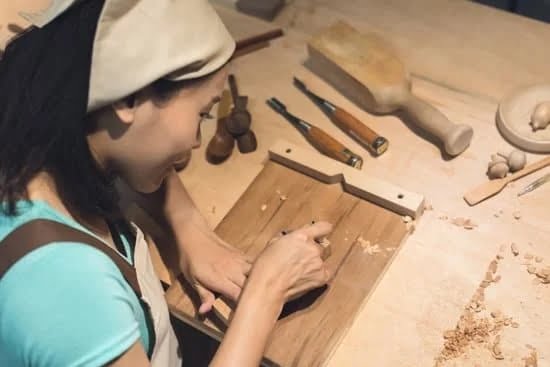Have you ever wondered how to touch up painted woodwork to keep it looking fresh and well-maintained? Over time, painted woodwork can become worn, chipped, or faded, affecting the overall appearance of your home or building. In this article, we will discuss the importance of touching up painted woodwork and provide a step-by-step guide on how to do so effectively.
Painted woodwork plays a significant role in enhancing the aesthetics of any interior space. Whether it’s baseboards, doors, window frames, or trim, maintaining the appearance of these elements is essential for preserving the overall look and feel of a room. It can also contribute to the value and appeal of a property. However, with regular wear and tear, painted woodwork may require touch-ups to restore its beauty.
In this section, we will explore why touching up painted woodwork is crucial for keeping your home or building looking its best. We will delve into the factors that contribute to the deterioration of painted woodwork over time and emphasize the importance of regular maintenance for preserving the visual appeal and integrity of these surfaces.
Tools and Materials Needed for Touching Up Painted Woodwork
When it comes to touching up painted woodwork, having the right tools and materials is essential for achieving a professional-looking finish. Before beginning the touch-up process, it’s important to gather all the necessary items to ensure that the job is done correctly and efficiently.
Some of the essential tools and materials needed for touching up painted woodwork include sandpaper, a paint scraper or putty knife, a high-quality paintbrush or roller, primer, and matching paint. These items can typically be found at hardware or home improvement stores. The cost of these items can vary depending on the quality and brand, but investing in high-quality tools and materials will ultimately result in a better overall finish.
In addition to the basic tools and materials, it’s also helpful to have some cleaning supplies on hand to prepare the surface for touch-up. This may include soap and water for washing the area, as well as a tack cloth or lint-free cloth for removing any dust or debris before applying new paint.
Having all of these items readily available before starting the touch-up process will make the job much smoother and ensure that everything is within reach when needed. Knowing how to touch up painted woodwork starts with having the right tools and materials at your disposal.
Preparing the Surface for Touching Up
Before you begin the process of touching up painted woodwork, it is crucial to properly prepare the surface to ensure a seamless finish. Over time, painted woodwork can become worn, chipped, or damaged due to everyday use and environmental factors. Preparing the surface before touching up the paint is essential for achieving professional-looking results and maintaining the appearance of your home or building.
To prepare the surface for touching up painted woodwork, you will need a few essential tools and materials. Here is a list of what you will need:
– Sandpaper: Choose fine-grit sandpaper to smooth out any rough areas and remove flaking or chipped paint.
– Tack cloth: Use a tack cloth to wipe down the surface and remove any dust or debris after sanding.
– Drop cloth or plastic sheeting: Protect the surrounding area from dust and paint splatter by covering it with a drop cloth or plastic sheeting.
Once you have gathered all the necessary tools and materials, follow these steps to prepare the surface for touch-up:
1. Clean the Surface: Use a mild detergent and water solution to clean the painted woodwork and remove any dirt or grime that has accumulated over time.
2. Sand the Area: Gently sand down any rough patches, flaking paint, or chipped areas until the surface is smooth and even.
3. Remove Dust: After sanding, use a tack cloth to wipe down the entire surface and remove any dust left behind from sanding.
Following these steps will ensure that the surface is clean, smooth, and free of any loose paint before applying touch-up paint. Taking the time to properly prepare the woodwork will result in a flawless finish that seamlessly blends with the existing paint.
By taking these preparatory steps before touching up painted woodwork, you can ensure that your touch-up paint adheres properly and creates a seamless finish. Proper preparation is key to achieving professional-looking results when addressing worn or damaged painted woodwork in your home or building. With just a few simple tools and materials, you can effectively prepare the surface for touch-up without needing to hire a professional.
Matching the Paint
When it comes to touching up painted woodwork, one of the most crucial steps is matching the new paint with the existing color of the woodwork. This can be a daunting task, but with the right approach and attention to detail, it can be done effectively. The key is to ensure that the touch-up paint seamlessly blends in with the rest of the woodwork, without any noticeable discrepancies in color.
To match the paint for your woodwork, begin by determining the type of paint originally used on the surface. If you have leftover paint from the initial painting job, this would be ideal for touch-ups.
However, if you don’t have any leftover paint, take a sample of the existing painted surface to a local hardware store or home improvement center. Many stores offer color matching services using advanced technology to identify and recreate custom colors for touch-up projects.
Another option is to consult with a professional painter or color specialist who can help you identify and replicate the exact shade and finish of your woodwork’s current paint. In some cases, they may even create a custom mix that perfectly matches your existing paint, ensuring a seamless touch-up process.
In addition to seeking professional assistance for color matching, there are also digital tools available that can help identify and replicate colors accurately. Some smartphone apps allow users to take a photo of their existing paint and receive a list of recommended paint colors that closely match the original. These high-tech solutions can aid in achieving an impeccable color match for touching up painted woodwork.
| Touch-Up Paint Matching Tools | Pro Tips |
|---|---|
| Local hardware store or home improvement center | Consider professional assistance for custom color matching |
| Consultation with professional painter or color specialist | Use digital apps for accurate color matching |
Applying the Touch-Up Paint
When it comes to touching up painted woodwork, the application of the paint is a crucial step in achieving a seamless finish. To start, make sure that the surface has been properly cleaned and prepared, as outlined in the previous section. Once the surface is ready, it’s time to apply the touch-up paint. Here’s how to do it effectively.
First, choose the right type of brush for the job. For small touch-ups, a small paintbrush with fine bristles will work best. Make sure to use a brush that matches the size and shape of the area you are painting to ensure precision and control.
Next, dip the brush into the paint and remove any excess by tapping it against the rim of the can. Start by applying a thin layer of paint to the damaged or worn areas. Be careful not to apply too much paint at once, as this can lead to drips or an uneven finish.
After applying the first coat, allow it to dry completely according to the instructions on the paint can. Once dry, assess if another coat is needed to achieve full coverage and blend with the existing painted woodwork.
It’s important to take your time during this process and be patient, as rushing can lead to mistakes that are difficult to correct. By following these steps carefully, you can achieve professional-looking results when touching up painted woodwork.
| Step | Description |
|---|---|
| 1 | Choose the right type of brush for small touch-ups. |
| 2 | Dip brush into paint and remove excess. |
| 3 | Apply thin layer of paint to damaged areas. |
| 4 | Allow first coat to dry completely before assessing if another coat is needed. |
Allowing the Paint to Dry and Cure
After applying the touch-up paint to the woodwork, it is important to allow it to properly dry and cure before using the surface. This ensures that the paint adheres well and provides a seamless finish. Here are some tips on how to ensure the paint dries and cures effectively.
Importance of Proper Drying
Proper drying of the touch-up paint is crucial for achieving a professional-looking finish. Rushing the drying process can result in uneven or streaky paint, as well as damage from handling the surface too soon. It is essential to follow the manufacturer’s instructions for drying times and environmental conditions, such as temperature and humidity, to achieve optimal results.
Protecting the Painted Area
During the drying process, it is important to protect the freshly painted area from any potential damage. This includes avoiding contact with objects or surfaces that could smudge or dent the paint. Placing warning signs or barriers around the area can alert others to avoid touching or brushing against the painted woodwork.
Curing Time
While paint may feel dry to the touch within a few hours, it is essential to allow it ample time to cure fully. Curing time refers to how long it takes for the paint to harden and adhere completely to the surface. Depending on the type of paint used, curing may take several days or even weeks. It is advisable to avoid placing heavy objects on or using the newly painted woodwork until it has fully cured.
By following these tips for allowing paint to dry and cure properly after touch-ups, you can ensure a long-lasting and pristine finish on your painted woodwork.
Finishing Touches
After touching up the painted woodwork, it’s important to add a protective finish or sealant to ensure that the fresh paint remains in good condition for as long as possible. Here are some finishing touches to consider:
- Applying a clear sealant: Once the touch-up paint has dried completely, consider applying a clear sealant to protect the woodwork. A clear sealant will help prevent chipping, fading, and other forms of damage that can occur over time. There are many options available, including polyurethane and varnish.
- Blending the touch-up paint: After allowing the touch-up paint to dry, it’s essential to blend it with the existing paint for a seamless finish. Use fine-grit sandpaper to carefully smooth out any edges or visible lines between the new and old paint. This will help create a uniform appearance and make it difficult to distinguish between the original paint and the touch-up areas.
- Adding a protective coating: Consider adding an additional protective coating over the entire painted woodwork once all touch-ups have been completed. This can further enhance the durability and longevity of the painted surface, especially in high-traffic areas or locations prone to wear and tear.
Incorporating these finishing touches into your touch-up process can result in beautifully restored, long-lasting painted woodwork. By taking these extra steps after touching up painted woodwork, you can ensure that your efforts yield professional-looking results that will stand the test of time.
Maintenance and Care Tips for Painted Woodwork
In conclusion, knowing how to touch up painted woodwork is an important skill for homeowners and building maintenance professionals alike. Over time, painted woodwork can become worn or damaged due to everyday wear and tear, exposure to sunlight, and regular use. It is essential to maintain the appearance of painted woodwork in a home or building to ensure that it continues to look its best and adds value to the property.
To successfully touch up painted woodwork, it is important to have the right tools and materials on hand. These may include sandpaper, paintbrushes, primer, matching paint, and a protective finish or sealant. It’s also crucial to properly prepare the surface for touching up by cleaning it and removing any existing flaking or chipped paint.
Matching the new paint with the existing color of the woodwork is another critical step in achieving a seamless finish. Taking a sample of the existing paint to get a perfect color match can ensure that the touch-up paint blends in seamlessly with the rest of the woodwork.
Additionally, allowing the paint to properly dry and cure, as well as applying a protective finish or sealant, are essential for long-lasting touch-up results. By following these maintenance and care tips for painted woodwork, individuals can maintain their property’s appearance and value for years to come.
Frequently Asked Questions
How Do You Touch Up Paint on Wood Trim?
Touching up paint on wood trim involves first cleaning the area, then sanding it lightly to create a smooth surface for the new paint to adhere to. Use a small brush to apply the paint in thin layers, allowing each layer to dry before adding more.
How Do You Touch Up Paint Without It Showing?
To touch up paint without it showing, start by using the same type of paint that was originally used on the surface. Then, feather the edges of the touched-up area by lightly brushing over them with a dry brush, blending the new paint into the old.
How Do You Repair Chips in Painted Woodwork?
Repairing chips in painted woodwork requires first cleaning the chipped area and allowing it to dry completely. Then use wood filler or spackling compound to fill in the chip, smoothing it out as much as possible. Once dry, sand the area and touch up with matching paint for a seamless repair.

Hi everyone! I’m a woodworker and blogger, and this is my woodworking blog. In my blog, I share tips and tricks for woodworkers of all skill levels, as well as project ideas that you can try yourself.





